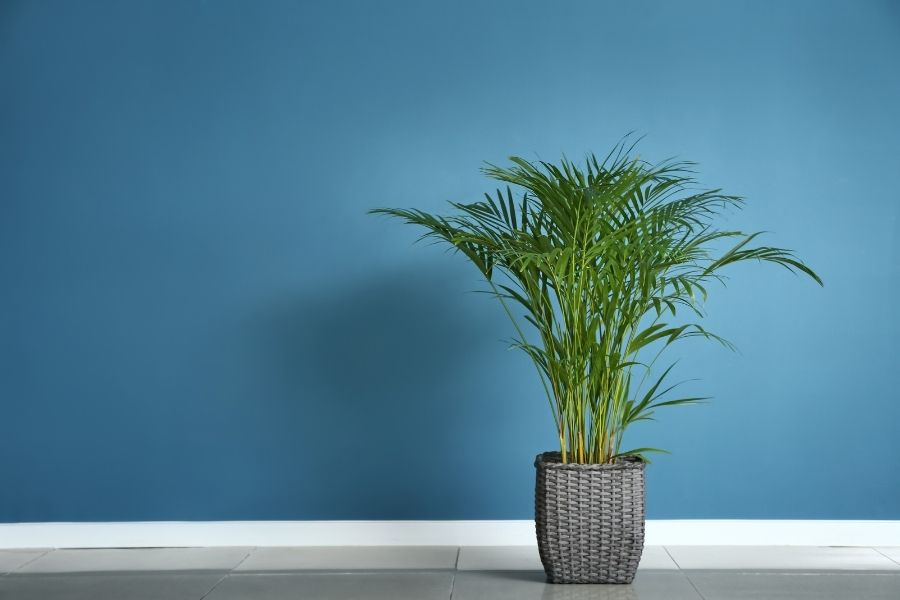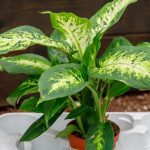
- TEMPERATURE: 65 – 75 degrees F (18 – 24 degrees C)
- LIGHT: Bright, indirect or direct sun
- HUMIDITY: Moderate
- SAFETY: Non-toxic to pets and humans
- DIFFICULTY: Moderate
Areca palm (Dypsis lutescens), also known as yellow palm or butterfly palm, is a popular houseplant that’s tolerant of indoor conditions, removes toxins from the air, and produces bold, attractive foliage.
A fast-growing palm, Areca features a cluster of cane-like stalks that produce feathery, upright yell0w-green fronds. It’s consistently rated as one of the best houseplants for removing indoor air toxins, which makes it a great plant for allergy sufferers.
I consider this plant moderately difficult to grow. If you can keep its humidity requirements met, provide adequate light, and avoid over-watering, Areca palm will stay very happy and not give you much trouble.
Water
Allow the soil to dry to 1-inch (2.5 cm) in depth before watering in spring through fall. I just insert my finger into the soil to the first knuckle. If the soil feels dry, it’s time to water. If you can feel moisture, it’s okay to wait another day.
In winter, reduce watering so the soil almost dries out completely. I typically water my Areca palm once every 10 days or so in the winter. Make sure you have good drainage and don’t allow the plant to sit in water.
Water with lukewarm water. Cold water straight from the tap can shock the plant.
Humidity
Mist Areca Palm daily to provide adequate humidity. This tropical houseplant will easily dry out if the humidity drops too low. In addition to misting, I recommend placing the plant on a tray filled with pebbles and water, and/or placing it near a good quality humidifier.
See my favorite houseplant humidifier review (the one I’m using right now), or click here to view it directly on Amazon.
Keep the plant away from heat sources (such as heating vents and wood stoves) and drafts.
Fertilizer
Feed your Areca palm once a month during spring through fall using a balanced houseplant fertilizer diluted to half-strength. My favorite is Jack’s All-Purpose Fertilizer, but any all-purpose food formulated for houseplants will work.
Read my review of Jack’s Fertilizer to see why I love it so much. I use it on almost all my houseplants except those that require special nutrients – like cacti and succulents.
Light
Areca palm needs bright, indirect light to full sun. It cannot tolerate low light conditions and needs plenty of sunlight to thrive.
If you find your plant is not doing well – dropping leaves or leaves turning yellow – it may be because it isn’t getting enough light. Move to a sunnier position in your home such as a south- or west-facing window.
North-facing windows will not provide enough light. This is not a plant for low-light homes. I’ve had a lot of trouble growing Areca because my house is so dark. I place it outside on the patio during summer through fall to make sure it gets adequate sunlight.
Temperature
Keep the temperature between 65 and 75 degrees F (18 – 24 degrees C) for the best results. Areca Palm can tolerate nighttime temperatures of 55 degrees F (12 degrees C), but this is not recommended and may kill some plants.
Try to keep temperatures warm at all times.
Potting
Plant your Areca palm in general purpose potting soil. I like this one by Happy Frog because it contains mycorrhizal fungi and beneficial soil microbes – but any good potting soil formulated for houseplants should work fine.
Choose a large pot 8 – 12 inches (20 – 30 cm) in size, and make sure it has several drainage holes. The plant cannot tolerate standing in water.
Repot every two to three years in spring, if the plant has become root-bound. Choose a pot at least 4 inches (10 cm) larger than its current container. Areca can handle the larger size because its a fast-grower.
Propagation
Areca palms are propagated from seed, and this is not something I recommend to the average indoor gardener. This is best left to greenhouse growers, as the gestation period is anywhere from 2 to 6 months.
Maintenance
If leaves turn brown or yellow, prune them away at the base using sterile pruning shears.
Troubleshooting
Here are some common problems you might have when growing Areca Palm indoors and how to fix them:
- Brown Frond Tips – If the tips of your fronds are turning brown, this is usually due to low humidity. The air is too dry, so the leaves begin to dry out. Increase humidity by placing the plant on a tray filled with pebbles and water, mist regularly with water, and/or place the plant near a humidifier.
- Yellow Leaves – If your leaves are turning yellow, this can be a sign the plant isn’t getting the nutrients it needs. Feed monthly during spring through fall using an all-purpose fertilizer diluted to half-strength. If you continue to have problems, a fertilizer with seaweed (kelp) may be beneficial for Areca Palm.
Where to Buy Areca Palm
Since this plant is so popular for homes and businesses, you should be able to find them at your local nursery or big box store (Walmart, Lowes, etc). Call around to your local nurseries to see if they have any available.
If you can’t find one locally, I recommend checking Etsy for Areca palm growers. I love buying houseplants on Etsy because you’re purchasing from individuals who care about the quality of the plants and their reputation (unlike some larger nurseries that sell online).
You can also check on Amazon. Many large and small nurseries sell through the Amazon marketplace. Click here to see the current Areca palm selections.




